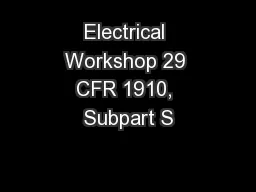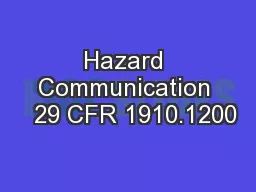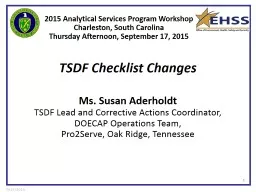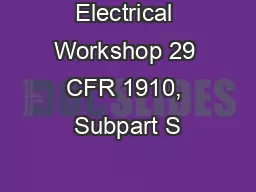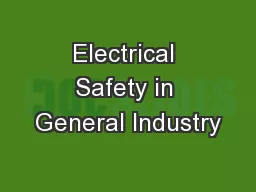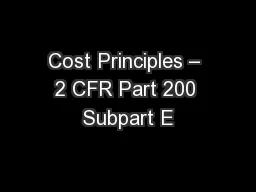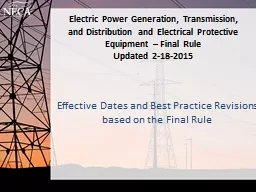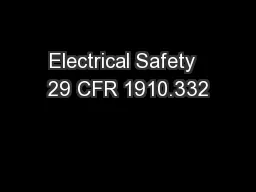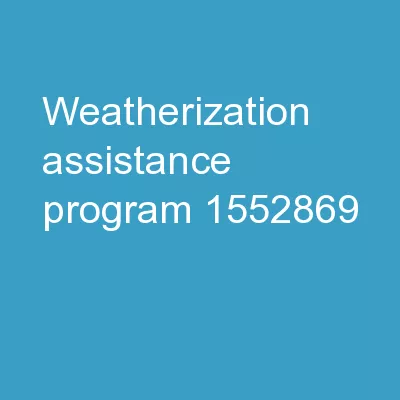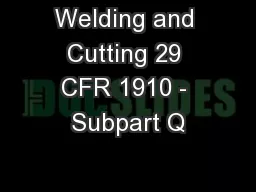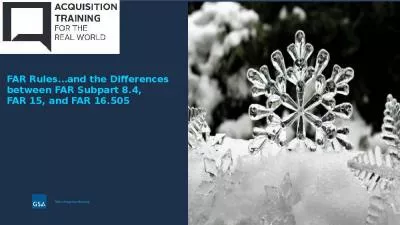PPT-Electrical Workshop 29 CFR 1910, Subpart S
Author : tatiana-dople | Published Date : 2019-02-27
29 CFR 1926 Subpart K Presented by ETTA OSH Division 9198072875 Objectives After completing this course students will Be aware of the basic principles of electricity
Presentation Embed Code
Download Presentation
Download Presentation The PPT/PDF document "Electrical Workshop 29 CFR 1910, Subpart..." is the property of its rightful owner. Permission is granted to download and print the materials on this website for personal, non-commercial use only, and to display it on your personal computer provided you do not modify the materials and that you retain all copyright notices contained in the materials. By downloading content from our website, you accept the terms of this agreement.
Electrical Workshop 29 CFR 1910, Subpart S: Transcript
29 CFR 1926 Subpart K Presented by ETTA OSH Division 9198072875 Objectives After completing this course students will Be aware of the basic principles of electricity Know how to work safely around electricity. OSHA. ’. s Mission. To Assure So Far as Possible Every Working Man and Woman in the Nation Safe and Healthful Working Conditions.... Enforcement Activity. 8/1/13 – 8/1/14. 865 Inspections nationwide in Eating and Drinking Places.. Walking - Working Surfaces. Presented by. : . ETTA. . Bureau, . (919) 807-2875. Objectives. In this course, we . will discuss:. Hazards. Definitions. General requirements. Guarding floor and wall openings and holes. Objectives. We will cover:. Purpose of hazard communication in the workplace. Role management and employees play in complying with this standard. General requirements regarding chemical hazards. Requirements for an effective written hazard communication program. OSHA Federal Standards. October 1, 2013 – September 30, 2014. GENERAL INDUSTRY . FY 2014. Most Frequently Cited Serious Violations in . General Industry 2014. 2. Overall 1910 MFC. Hazard Communication – Written Program. OSHA Federal Standards. October 1, 2016 – September 30, 2017. GENERAL INDUSTRY . FY 2017. Most Frequently Cited Serious Violations in . General Industry 2017. 2. Overall 1910 MFC. Hazard Communication – Written Program. Charleston, South Carolina. Thursday Afternoon, September 17, 2015. TSDF Checklist Changes. Ms. Susan Aderholdt. TSDF Lead and Corrective Actions Coordinator, . DOECAP Operations Team,. Pro2Serve, Oak Ridge, Tennessee. 29 CFR 1926, Subpart K. Presented by. : ETTA, OSH Division, 919-807-2875. Objectives. After completing this course, students will:. Be aware of the basic principles of electricity . Know how to work safely around electricity. . §1910 . Subpart “S“. . Presented by. : ETTA, OSH Division, (919) 807-2875. Objectives. In this course, we will discuss the following. :. Common electrical hazards. Electrical utilization systems. U.S. Department of Education. Purpose and Use of this Presentation. The Department of Education is providing this presentation to help its grantees understand the contents of the Uniform Guidance and should be viewed after or alongside of the regulations. It is not a substitute for reading the regulations. . Updated 2-18-2015. Effective Dates and Best Practice Revisions based on the Final Rule. Electric Power Generation, Transmission, . and . Distribution and Electrical Protective Equipment – Final Rule . Safety Training Presentations. Institute of Occupational Safety and Health. FY-11 OSHA Susan Harwood Grant Program. This material was produced under grant . number . SH22297-SH1. . from OSHA. It does not necessarily reflect the views or policies of the U.S. Department of Labor, nor does mention of trade names, commercial products, or organizations imply endorsement by the U.S. Government. . Uniform Administrative Requirements, . Cost Principles, and Audit Requirements. For . Federal Awards. March 2015. Workshop Goals. To introduce participants to the Uniform Administrative Requirements, Cost Principles, and Audit Requirements for Federal Awards. Presented by. : ETTA, OSH Division, (919) 807-2875. Objectives. In this course, we will discuss:. Fire hazards associated with welding. Selection of eye protection for welding operations. Management’s responsibility . FAR 15, and FAR 16.505. Office of Integrated Marketing. Introduction to the MAS Program. What is a Multiple Award Schedule?. Governmentwide contract vehicle for commercial products, services, and solutions.
Download Document
Here is the link to download the presentation.
"Electrical Workshop 29 CFR 1910, Subpart S"The content belongs to its owner. You may download and print it for personal use, without modification, and keep all copyright notices. By downloading, you agree to these terms.
Related Documents

